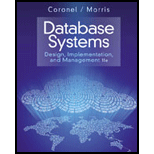
a)
Transaction:
A transaction is a logical unit of work.
- A sequence of process that must be completely completed or aborted.
- Intermediate states are not acceptable in the process of transaction.
- To make a transaction use a keyword “BEGIN TRANSACTION;”, insert SQL queries and commit the transaction.
Syntax for “TRANSACTION”:
BEGIN {TRANSACTION|TRAN};
SQL queries;
COMMIT;
“insert” query:
The INSERT command in SQL is employed to add records to an existing table. INSERT will increase the number of rows in a table.
Syntax for INSERT command:
INSERT INTO table_name VALUES (value1, value2…);
Example:
INSERT INTO employee VALUES(101, ‘Smith’,10);
“update” query:
The UPDATE command is employed to update information present in a table.
It is always used with SET keyword either in bulk or individually. UPDATE will not increase the number of rows in a table.
Syntax for UPDATE command:
UPDATE table_name SET column_name1 = value WHERE some_condition;
Example:
UPDATE employee SET name= ‘Presil’ age= 24 WHERE id=115;
b)
Explanation of Solution
Program plan:
The following SQL query is to make a customer payment for a customer “10010” of “$100” in cash using the payment ID “3428”.
- Begin the transaction.
- Insert the appropriate values into “payments” table using “insert” query.
- Update the customer details to reduce the customer balance by “100” for the customer “10010” using “update” query...
Trending nowThis is a popular solution!

Chapter 10 Solutions
Database Systems: Design, Implementation, & Management
- what is a feature in the Windows Server Security Compliance Toolkit, thank you.arrow_forwardYou will write a program that allows the user to keep track of college locations and details about each location. To begin you will create a College python class that keeps track of the csollege's unique id number, name, address, phone number, maximum students, and average tuition cost. Once you have built the College class, you will write a program that stores College objects in a dictionary while using the College's unique id number as the key. The program should display a menu in this order that lets the user: 1) Add a new College 2) Look up a College 4) Delete an existing College 5) Change an existing College's name, address, phone number, maximum guests, and average tuition cost. 6) Exit the programarrow_forwardShow all the workarrow_forward
- Show all the workarrow_forward[5 marks] Give a recursive definition for the language anb2n where n = 1, 2, 3, ... over the alphabet Ó={a, b}. 2) [12 marks] Consider the following languages over the alphabet ={a ,b}, (i) The language of all words that begin and end an a (ii) The language where every a in a word is immediately followed by at least one b. (a) Express each as a Regular Expression (b) Draw an FA for each language (c) For Language (i), draw a TG using at most 3 states (d) For Language (ii), construct a CFG.arrow_forwardQuestion 1 Generate a random sample of standard lognormal data (rlnorm()) for sample size n = 100. Construct histogram estimates of density for this sample using Sturges’ Rule, Scott’s Normal Reference Rule, and the FD Rule. Question 2 Construct a frequency polygon density estimate for the sample in Question 1, using bin width determined by Sturges’ Rule.arrow_forward
- Generate a random sample of standard lognormal data (rlnorm()) for sample size n = 100. Construct histogram estimates of density for this sample using Sturges’ Rule, Scott’s Normal Reference Rule, and the FD Rule.arrow_forwardCan I get help with this case please, thank youarrow_forwardI need help to solve the following, thank youarrow_forward
 Database Systems: Design, Implementation, & Manag...Computer ScienceISBN:9781305627482Author:Carlos Coronel, Steven MorrisPublisher:Cengage Learning
Database Systems: Design, Implementation, & Manag...Computer ScienceISBN:9781305627482Author:Carlos Coronel, Steven MorrisPublisher:Cengage Learning Database Systems: Design, Implementation, & Manag...Computer ScienceISBN:9781285196145Author:Steven, Steven Morris, Carlos Coronel, Carlos, Coronel, Carlos; Morris, Carlos Coronel and Steven Morris, Carlos Coronel; Steven Morris, Steven Morris; Carlos CoronelPublisher:Cengage Learning
Database Systems: Design, Implementation, & Manag...Computer ScienceISBN:9781285196145Author:Steven, Steven Morris, Carlos Coronel, Carlos, Coronel, Carlos; Morris, Carlos Coronel and Steven Morris, Carlos Coronel; Steven Morris, Steven Morris; Carlos CoronelPublisher:Cengage Learning A Guide to SQLComputer ScienceISBN:9781111527273Author:Philip J. PrattPublisher:Course Technology Ptr
A Guide to SQLComputer ScienceISBN:9781111527273Author:Philip J. PrattPublisher:Course Technology Ptr Np Ms Office 365/Excel 2016 I NtermedComputer ScienceISBN:9781337508841Author:CareyPublisher:Cengage
Np Ms Office 365/Excel 2016 I NtermedComputer ScienceISBN:9781337508841Author:CareyPublisher:Cengage





